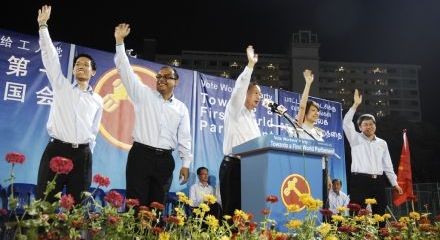15.05.2025

Small island prospects
As expected the ruling party has just been re-elected. However, what are the chances for the left and the working class within the confines of a tiny authoritarian city state with an AAA credit rating that serves as a financial hub and tax haven? Billy Clark gives his take on things
On May 3, the city-state of Singapore elected its 15th parliament, returning a massive majority in favour of the ruling People’s Action Party, as it has in every election since 1959. The ‘centre-left’ Workers’ Party remains the only other party with elected representatives, maintaining its 10 seats across three contiguous constituencies from 2020. It has also gained two non-constituency MPs.1 The turnout was 92.5%, which sounds high in Britain, but is actually a record low.2
The 12 seats out of 97 for the WP sounds fairly dismal. But it might appear more of an achievement, when seen in the context of Singapore’s history since separation from the Malay Federation in 1965: PAP (once a broad, anti-colonial party, which benefited from its prominent leftists and links with trade unions), in order to consolidate its grip on power, largely succeeded in expelling and muzzling its own left and those outside its ranks - and working class independence with it.
From 1966-81 there were no opposition politicians in parliament at all, and before 2020 there were never more than single figures elected. Historian PJ Thum defines Singapore as a “parliamentary dictatorship”, and often makes the point that, although Singapore ceased to be a ‘British subject’ in 1963, the government has never moved on from colonialism.
Gerrymandering helps understanding the results. Instead of placing constituency boundaries around obvious, natural communities, they are drawn up in a way that helps the ruling party. The Electoral Boundaries Review Committee announced its changes for the 2025 election as late as March 11. Combined with the usual early election call, this meant parties did not have long to find suitable candidates and campaign in the new boundaries. The EBRC allows no public consultation and is not transparent about how exactly its decisions are made.
First past the post elections also favour a two-party system, and the fact that PAP has 90% of seats with 65% of the votes demonstrates the problem. Furthermore, the high election deposit cost and high threshold to keep it discourages smaller parties from fielding candidates.
Singapore now consists of 14 single-member constituencies (SMCs, electing one MP), and 16 ‘group representation constituencies’ (GRCs), in which a party stands a slate of up to five MPs. The use of GRCs - ostensibly to improve representation of minorities (ie, non-Chinese) in parliament - is just another aspect of gerrymandering. The former SMC of Bukit Batok is a good illustration. In 2020, Chee Soon Juan of the Singapore Democratic Party (SDP) received 45% there, and it was assumed he would come even closer to winning if he stood again. But Bukit Batok was absorbed into a new GRC, dominated by previous PAP strongholds, and the result was a 76% victory for the PAP slate.
The strategy of other parties - which is not based on seeking to form a government, but on creating a more robust minority and a “more balanced parliament” - appears to have failed. It was clear to voters that no party was standing in enough places to get anywhere near winning a majority (WP had the most opposition candidates with only 26). The recent increase in taxation has been very unpopular, but voters knew that there was little point in voting for the so-called opposition parties against the incumbent government.
Elimination
So far I have not talked in terms of left versus right, but of government versus opposition. This reflects the content of the different parties’ campaigns. All parties and independent candidates have released manifestos, but their messaging was mostly about increasing the opposition, rather than the policies they intend to introduce. The fact is, there is no left presence in Singapore.
The crackdowns on the Barisan Sosialis and PAP left in 1963, the detainment without trial of those suspected of involvement in a ‘Marxist conspiracy’ in 1987, and the elimination of independent and left unions have led to a situation where few dare to endorse socialism of any sort.
Nevertheless, it may be useful to think about what the political priorities might be for an emergent organised left.
One of these must be the abolition of the death penalty - which is mandatory for drug trafficking. There are some particularly egregious cases in Singapore’s recent history. Nagaenthran K Dharmalingam was hanged in 2022 for attempting to smuggle heroin. He had a learning disability and claimed to have been forced and threatened into doing so, but appeals against his execution were rejected.
Polling from 2024 shows that over three quarters of Singaporeans approve of capital punishment. An even larger majority believe it to be an effective preventative, though this is far from clear. What is more, lawyers working for death row prisoners and activists against the death penalty are subject to state harassment and censorship. Most recently, the advocacy group, Transformative Justice Collective, has been prohibited from using its website or social media accounts until December 2026. No party is opposed to capital punishment outright, and only the WP opposes the mandatory death penalty, although even this has not featured in its campaigning.
Then there is immigration. Singapore’s cleanliness, its attractive public housing, and its seamless, efficient public transport are the product of the exploitation in particular of the migrant workforce, whose plight is largely concealed from the resident population. These workers - there are some 250,000 of them - are drawn from other Asian countries to build up and maintain the city and their position must be addressed in a socialist programme. 90% of Singapore’s non-resident workforce are these low-wage, temporary migrant workers, who cannot change their jobs, bring in their family nor stay for more than two years typically. Making a complaint or trying to receive compensation involves so much bureaucracy that few workers are successful - if they are not first put off by the fear of sudden deportation, lorded over by their bosses.
Life for male workers is characterised by cramped dormitories, while the isolation of women in domestic work means they are unlikely to learn about their rights or find a way to address abuse on the job. Laws have been passed to protect migrant workers from the worst employment practices, but the best of these are only sporadically applied, while others have led to employers imposing additional fees on the worker, stagnating their wages. Far from returning to Bangladesh wealthy, migrant workers are more often left vulnerable to debt bondage, and unable to achieve the milestones they had dreamt of.
Spontaneous actions by migrant workers have joined older events like the Hock Lee riots of 1955 in being used to justify the government’s ‘racial harmony’ policy, used to prevent public debate around racism and religion. Workers need to reclaim such events as a part of their own history. In 2012, 131 bus drivers from China struck against dormitory conditions and unequal pay. They were deported without trial, but their action had the effect of improving living conditions for bus drivers at this company, and establishing equal pay for all non-resident drivers.
How migrant workers are perceived is subject to the whims of the elite: depending on current immigration policy, politicians can fan the flames of xenophobia one year and condemn it the next. Temporary migrant workers cannot vote, of course, and have no avenue for involving themselves in politics. It is no wonder that such workers feel they have no stake in Singaporean society.
Political freedom
The PAP’s willingness to flip its rhetoric on migration and race is a symptom of the fact that there is no logically consistent bourgeois approach to immigration and free movement. Working class Singaporeans, who have no minimum wage, correctly see the reliance on migrant workers as suppressing their wages. Measures that reduce competition between workers, such as the right to collective bargaining in independent unions and a living wage based on maximum hours, are the only way forward.
Another priority for socialists must be increased political freedom: this will not be achieved by having more dissenting MPs, but would necessarily constitute a challenge to the state form. With the election date announced, Kirsten Han used her newsletter entitled We, the citizens to define various institutions that are supposed to be distinct, but are often used interchangeably: state, government and party. Confusion is understandable, as only one party has ever governed and most of its new candidates are recruited from the civil service and military.
Civil Service
One feature of a partisan civil service is that there is no distinction between public and party money. PAP is hostile to welfare, but leading up to elections it used state reserves to introduce a popular measure. A scheme in Bukit Panjang, which provided monthly $1 meals, explains why the SDP received only 38% in a constituency where it expected to perform well. The prime minister and others can credibly make threats that voters will lose various funding if they vote the wrong way. Such rhetoric is always abundant in the campaigning period, but it seems to have not bothered those who actually live in WP-controlled areas.
This level of political and ideological control means dissent is easily and tightly policed. Even the meekest of actions can be met with arrest and possible prosecution. This includes a recent “no-person protest” in memory of those murdered in Gaza, which involved arranging shoes in front of a university building, and resulted in a raid on the homes of the students involved. A ‘speakers’ corner’ was tokenistically introduced in 2000 as a ‘free speech zone’ - provided the actual ‘free speech’ is first registered with the police.
Workers in Singapore have no genuinely independent trade unions at all - every so-called union comes under the government-controlled NTUC, whose aim is the maintenance of “harmonious industrial relations”.
Singapore has all the artifices and procedures expected of a so-called bourgeois democracy, but has never had a free and fair election (the closest it came was 1955, when still a British colony), and a proper separation of powers.
-
Non-constituency MPs have the same voting rights as those elected and at present these positions go to the two losing opposition candidates with the highest vote percentage.↩︎
-
Singapore has a compulsory voting system. Anyone who does not vote and cannot prove a good reason is removed from the electoral roll and must pay a fine to be re-entered.↩︎
